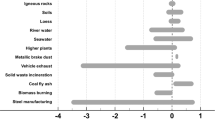Abstract
Trace species in atmospheric particles have frequently been used to apportion pollutants in acid rain to their sources by comparing the relative concentrations of trace species at the source and receptor sites. Another approach is to use the trace species in precipitation directly in a source apportionment. This has rarely been done due to the paucity of data on trace species in precipitation and the unknown fractionation of the species during the scavenging process. A study was undertaken to analyze precipitation for a large number of trace species and to compare the concentrations with those in atmospheric particles. Precipitation was collected in Lenox, MA during the summer of 1984. Extreme measures were taken to avoid contamination during collection and analysis. Using five analytical methods, including the novel method of freeze-drying the precipitation followed by neutron-activation analysis, 31 species were analyzed in the rain. The trace concentrations measured in this study were lower than those found in earlier studies, where contamination was believed to be a problem. Concentrations of trace species in the precipitation were compared with those in atmospheric particles. A few species were enriched in precipitation relative to particles, including some large-particle species (Ca, Ti, Fe) and species with gaseous precursors (SO4, NO3, Br). Due to this enrichment, these species should be carefully considered before using them in source apportionment calculations. However, most species showed similar enrichments in precipitation and in atmospheric particles, suggesting that negligible fractionation had taken place during the scavenging process. These species could be used effectively in the future to apportion the pollutants in precipitation to their various sources.
Similar content being viewed by others
References
Barrie, L. A., Lindberg, S. E., Chan, W. H., Ross, H. B., Arimoto, R., and Church, T. M.: 1987, Atmos. Environ. 21, 1133.
Chan, W. H., Tang, A. J. S., Chung, D. H. S. and Lusis, M. A.: 1986, Water, Air, and Soil Pollut. 29, 373.
Crowther, J. and McBride, J.: 1981, Analyst 106, 702.
Davison, R. L., Natusch, D. F. S., Wallace, J. R., and Evans, C. A.: 1974, Environ. Sci. Tech. 8, 1107.
Dutkiewicz, V. A., Parekh, P. P., and Husain, L.: 1987, Atmos. Environ. 21, 1033.
Edinger, R. D.: 1973, Atomic Absorption Newsletter 12, 151.
Galloway, J. N., Thornton, J. D., Norton, S. A., and Volchok, H. L.: 1982, Atmos. Environ. 16, 1677.
Gordon, G. E., Zoller, W. T., and Gladney, E. S.: 1974, ‘Abnormally Enriched Elements in the Atmosphere’, in Hemphill, D. D. (ed.), Trace Substances in Environmental Health, University of Missouri.
Harrison, S. H., LaFleur, P. D., and Zoller, W. H.: 1975, Anal. Chem. 47, 1686.
Heaton, R. and Rahn, K. A.: 1986, ‘In-cloud oxidation of SO2 as deduced from trace elements in aerosol and precipitation’, in Proceedings of the Symposium on Heterogeneous Processes in Source-dominated Atmospheres, New York.
Mason, B.: 1966, Principles of Geochemistry, Wiley and Sons, Inc., NY.
NADP Annual Data Summary, 1982: 1985, National Atmospheric Deposition Program.
Pierson, D. H., Cawse, P. A., Salmon, L., and Cambray, R. S.: 1973, Nature 241, 252.
Rahn, K. A:: 1976, ‘The Chemical Composition of the Atmospheric Aerosol’, U. of Rhode Island, Graduate School of Oceanography Technical Report.
Rahn, K. A. and Heaton, R.: 1986, ‘Further Development of Regional Elemental Tracers for Contaminants in Precipitation’, Research Proposal to the USEPA.
Rahn, K. A. and Lowenthal, D. H.: 1985, Science 228, 275.
Schroeder, W. H., Dobson, M., Kane, D. M., and Johnson, N. D.: 1987, J. Air Pollut. Control Assoc. 37, 1267.
Topol, L. E.: 1986, Atmos. Environ. 20, 347–356.
Tramontano, J. M., Scudlark, J. R., and Church, T. M.: 1987, Environ. Sci. Technol. 21, 749.
U.S. Dept of Agriculture: 1977, Soil Survey of Wayne Country Area, Michigan Soil Conservation Service.
Wolff, G. T.: 1987, ‘Visibility-reducing species in New England's Berkshire Mountains’, in Bhardwaja, P. S. (ed.), Visibility Protection. Research and Policy Aspects, Air Pollution Control Association, Pittsburgh, Pa, pp. 453–463.
Wolff, G. T.: 1989, ‘Estimates of Regional Contributions to Wet Acid Deposition in Western Massachusetts During the Summer of 1984’, Atmos. Environ. (in press).
Wolff, G. T. and Korsog, P. E.: 1989, ‘Atmospheric Concentrations and Source Regions of Sulfate, Nitrate and Sulfur Dioxide in the Berkshire Mountains in Western Massachusetts’, Atmos. Environ. 23, 55.
Author information
Authors and Affiliations
Rights and permissions
About this article
Cite this article
Dasch, J.M., Wolff, G.T. Trace inorganic species in precipitation and their potential use in source apportionment studies. Water Air Soil Pollut 43, 401–412 (1989). https://doi.org/10.1007/BF00279205
Received:
Revised:
Issue Date:
DOI: https://doi.org/10.1007/BF00279205




